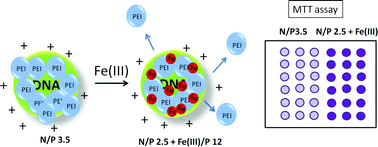Ternary complexes DNA–polyethylenimine–Fe(iii) with linear and branched polycations: implications on condensation, size, charge and in vitro biocompatibility
Abstract
The successful use of nucleic acids in medicine requires efficient DNA condensation and protection, as well as a low cytotoxicity of the vector. In previous work, we have used a ternary DNA–PEI–Fe(III) complex and have shown that the addition of Fe(III) to the DNA–PEI complexes enhances DNA condensation, whereas allows an easier DNA release from the complexes, in the presence of a decompacting agent. The focus of the present work was to investigate the influence of the polycation architecture on the DNA–PEI–Fe(III) ternary system, and also to develop a potential gene delivery system with reduced toxicity. Herein, lPEI (2.5 and 25 kDa) and bPEI (1.2 and 10 kDa) were used in conjunction with Fe(III), and the complexes formed were physico-chemically characterized using precipitation and gel electrophoresis assays, and size and zeta potential determinations. It was observed that the addition of Fe(III) ions equalizes the charge ratios for the onset of DNA condensation irrespective of the PEI used, although a more pronounced condensation effect is still visible with the polycations with a lower Mw. At low N/P ratios, the presence of Fe(III) caused the zeta potential to change from negative to positive values. Also, a reduction in polyplex size is visible before aggregation takes place. The hemolytic activity of the condensing agents was found to be dependent on the pH of the medium, but no perturbation of erythrocytes integrity was detected. Furthermore, the cytotoxicity of each condensing agent individually and of the complexes towards 3T3 fibroblast cell line and HeLa cell line was monitored using the MTT and LDH assays. The magnitude of the cytotoxic effects of the polycations and Fe(III) was found to be dependent on the concentration of the condensing agents, the molecular weight of the polycations, and the pH of the culture medium. The combination of Fe(III) with PEI determines higher IC50 values than in the absence of the metal ion. Additionally, a lower cytotoxicity of DNA–PEI–Fe(III) complexes was observed, when compared to native PEI–DNA complexes, at the same degree of condensation and values of zeta potential. The results show that Fe(III) reinforces the DNA–PEI condensation in both PEI architectures. It allows the cytotoxicity of PEIs to be mitigated and the concentration of the latter needed to obtain stable polyplexes to be decreased.


 Please wait while we load your content...
Please wait while we load your content...